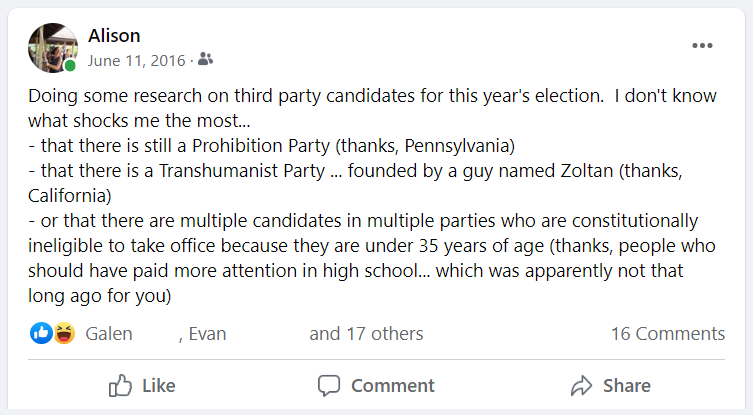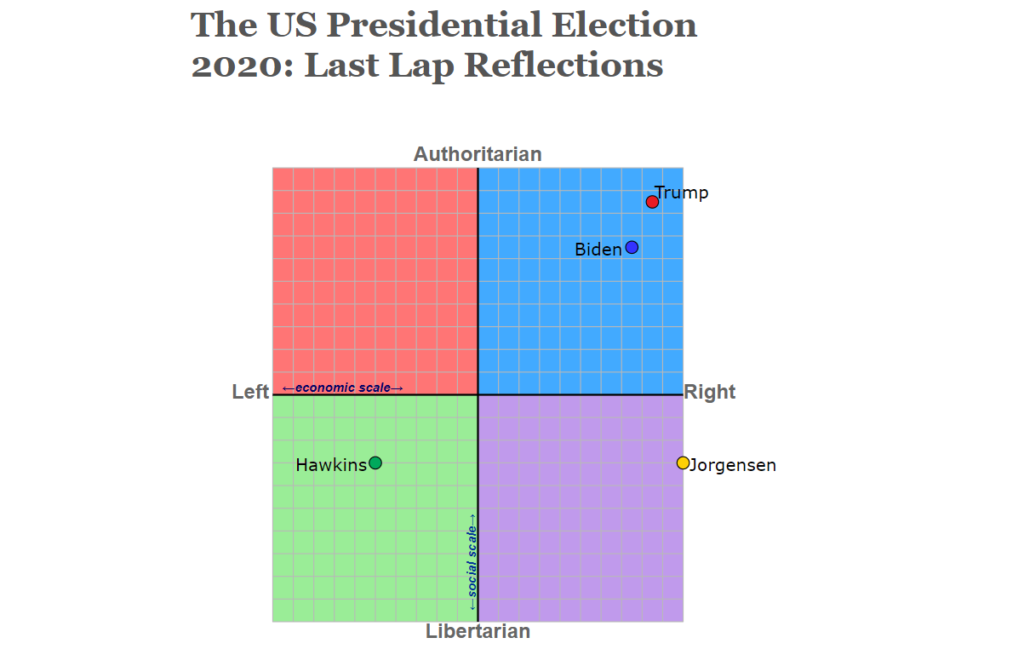Part 1 – Parties
After three years of blogging about local, state, and federal elections, there aren’t many types of races I haven’t covered at this point, with one notable exception: that for the role of governor. Governor, US Senator, and US Representative are the big names on my ballot this year – and I do plan to get to them in a little more detail in this series, but I will (once again) stress the critical importance of down-ballot races, not just in the midterms, but always.
Another important thing to keep in mind when it comes to evaluating candidates on your ballot is the fact that we generally have more than two options, especially in larger races. There are, in fact, five different parties represented in the top three races on my ballot this year, including a brand new one. While I personally am not a fan of political parties, I am going to take this opportunity to review what these parties purport to represent (though your mileage may vary with individual candidates). I will also do my best to refrain from calling out highly questionable or seemingly hypocritical rhetoric from any party, but I would encourage you – as you read – to remember that this is marketing language from the parties themselves, not objective facts.
Democratic Party [1]
The PA Democratic party was founded in 1792. Current high priority issues mentioned on their website include:
- Protecting voting rights
- Protecting reproductive healthcare
- Addressing the gun violence crisis
- Creating stable, good-paying jobs
Green Party [2]
The PA Green party was formally created in 1996, though Green Party candidates have been running for office in the state since 1993. The party’s 10 key values are listed as such on their website:
- Grassroots democracy
- Social justice and equal opportunity
- Ecological wisdom
- Nonviolence
- Decentralization
- Community-based economics and economic justice
- Feminism and gender equality
- Respect for diversity
- Personal and global responsibility
- Future focus and sustainability

Keystone Party [3]
This name may be unfamiliar to you, and that’s for good reason. The Keystone party is described as “newly-formed” in an August 2022 article in political news source City & State.[4] Founding members of the Keystone party cited frustration with major political parties and their lack of effectiveness as the impetus for their actions to start from scratch. According to the party’s official website, their very detailed list of priorities consists of the following (condensed by me):
- Governmental reform –
Including term limits, anti-corruption measures, support of individual rights, and balanced budgets - Fair elections –
Including equitable ballot access, independent redistricting commissions, ranked choice voting (more on that later!), and limits on public funding for primary elections until they are open to every registered voter - Social reforms –
Including in the areas of criminal justice, the education system, the environment, and healthcare - Criminal justice reform –
Including more reasonable approaches to victimless crimes and awareness of jury nullification - Individual rights –
Including freedoms of self defense, speech, religion, and relationships - Economics –
Including support of free markets, balanced regulation, right to private property, limited taxation, and the repeal or simplification of most land use regulations - Immigration –
Including streamlining immigration processes, allowing peaceful people to participate in guest worker programs, become permanent residents, or seek citizenship - Privacy –
Including strong data privacy laws and strong banking secrecy laws - State Preservation –
Including the right to limit the National Guard’s obligations to the federal branch, such as being sent overseas without a declaration of war or an insurrection
Libertarian Party [5]
The Libertarian party was founded in 1971, and they first came to my attention in college when I was about to vote in my first presidential election. I was thrilled by the prospect of a party that touted the social inclusivity I heard about on the left and the fiscal responsibility I heard about on the right. (Full disclosure: I have identified most closely with this party since I began voting, regardless of my party registration, which has changed over time.) While I’ve encountered many self-identifying Libertarians who sound a lot more like mainstream Republicans, the official priorities of the party, which are formally updated every two years, include:
- Taxes –
If Americans want to give money to the government for one reason or another, they should be free to do so. If Americans prefer to spend their money on other things, then they should be free to do that also. - The economy –
Libertarians believe that all people have the right to freely offer goods and services on the market and that free-market approaches are the most effective at improving people’s lives. - Civil liberties –
Libertarians believe that the equal rights of all people matter all the time. No exceptions. - Crime and justice –
Libertarians believe that the existing justice system is seriously flawed. - Education –
Libertarians advocate for a free market in education in which parents, teachers, and students, not the government, would make their own choices. - Foreign policy –
Libertarians seek a United States at peace with the world. - Healthcare –
Libertarians believe that healthcare prices would decrease and quality and availability would increase if healthcare was freed from government meddling and control. - Gun ownership –
Libertarians believe that every person has the right to arm themselves in self-defense. - War on drugs –
Libertarians believe that the War on Drugs is ineffective, unfair, and immoral. We advocate ending it. - Immiration –
Libertarians believe that if someone is peaceful, they should be welcome to immigrate to the United States.

Image credit: [6]
Republican Party [7]
The PA Republican Party dates back to 1854. Their current platform, according to their website, consists of the following four priorities:
- Protecting the American Dream –
We believe in creating an environment where everyone who will work hard has the opportunity to achieve the American Dream - Protecting Communities –
We believe in enforcing the law and prosecuting crime, and we believe in supporting the law enforcement community - Protecting Families –
We believe in the right to life, parents’ rights to be involved in their child’s education, and we believe that families, schools, and students benefit from school choice - Protecting Taxpayers –
We believe in fighting for individuals’ rights in opposition to a large, bloated government
For years I have railed against the two-party system, as neither one of the major parties accurately reflects my values and priorities. I know that there will never be a perfect candidate for me (or for anyone who exercises critical thought), but I refuse to be bullied into settling for the lesser of two evils when there is someone much more qualified and/or desirable on the ballot. Unfortunately, the way elections are set up in Pennsylvania (and most places) supports the dominance of the two-party system and leaves us with candidates who are more likely to represent positions of extremists on the ends of the spectrum, rather than the majority in the middle.
Ranked Choice Voting
Having identified with a third party since college, I know how difficult it can be to get third party candidates on the ballot, to say nothing of getting them on stage at debates. There is one measure, however, that could prove helpful in leveling the playing field if it is adopted here in Pennsylvania, one that will help voters know that they have more options and force candidates to pay more attention to what matters to their constituents. That measure is called “Ranked Choice Voting,” or RCV.

Adapted image credit: [8]
The idea behind this process is that instead of voting for one candidate, voters will indicate their first, second, third, etc. choices in order of preference, including not voting at all for candidates who would be absolute deal-breakers. For a larger field of candidates, such as in this upcoming election, a system like this would be beneficial for a number of reasons. If one candidate earns more than 50% of the vote, that person becomes the winner. However, if no one gets the majority of the votes, RCV would take the place of a runoff election by eliminating the last place candidate and redistributing those first-choice votes to the second-choice candidates. This process would continue until someone reached a majority.
In addition to being a cheaper option than a runoff election, there are arguments that the process would be more fair across parties. Third party candidates (and their supporters) are frequently ostracized for detracting votes from one of the two major parties and therefore risking a loss for a leading candidate. Using RCV, voters could vote for their candidates of choice AND the more closely aligned major party candidate, if they so chose. Some detractors argue that it won’t help third party candidates or our country’s polarization problem that much, but I can’t see how it could possibly hurt.
RCV has already been implemented statewide in Maine and Alaska, in 53 cities, for some military and overseas voters, as well for some special elections.[9] In 2021 the Pennsylvania house proposed a state constitutional amendment to implement RCV for primary and general elections, and earlier this year the Pennsylvania senate introduced legislation to authorize RCV for local elections. There hasn’t been any movement on either yet, so if it is something of interest to you, I encourage you to make your feelings known to your elected officials. It won’t help for this upcoming election, but maybe soon after. You can also sign up for updates on local and national initiatives here.[10]
~
And here, as always, is my candidate research spreadsheet for this election. It may still be subject to changes in the coming weeks. (Please let me know if you spot anything inaccurate!)
Tune in next week when we bring it back to races on the current ballot and what might be impacted by the next occupant of the highest office in the state.
Thanks for reading!
[3] https://www.keystone.party/
[4] https://www.cityandstatepa.com/politics/2022/08/what-keystone-party-city-state-explainer/376294/
[6] https://www.politicalcompass.org/uselection2020
[8] https://www.rankedvote.co/guides/understanding-ranked-choice-voting/pros-and-cons-of-rcv
[10] https://fairvoteaction.org/get-involved/reform-allies/
0 Comments